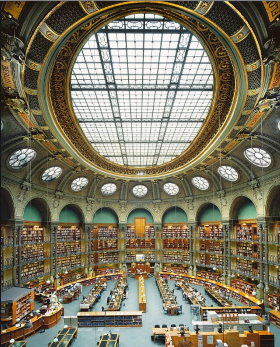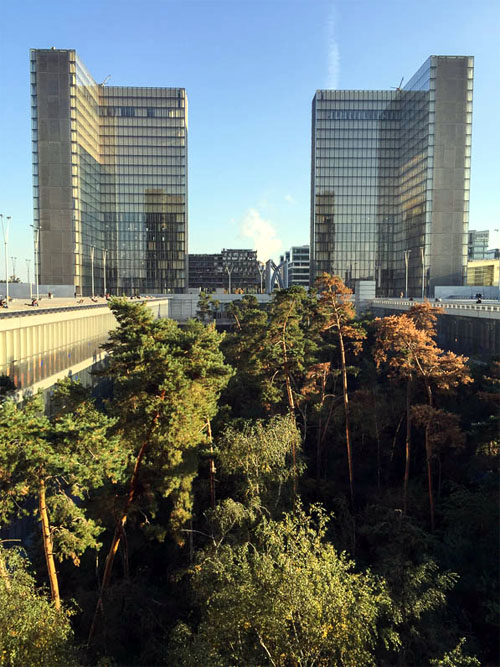Bibliothèque Nationale de France - Paris

The Bibliothèque Nationale de France, also called BNF, is the French national library. BNF preserves the French national documentary heritage. Its collections include 15 million books, manuscripts, prints, photographs, videos. BNF's two main sites in Paris are Bibliothèque Richelieu, the historical site, and Bibliothèque François Mitterand. Top Paris monuments.
Bibliothèque Nationale de France Richelieu
The Richelieu site is the historic cradle of the National Library of France and its exceptional collections. It was originally the palace of Cardinal Mazarin, built in the 17th century. In 1721, the King's library moved there. It reopened its doors in 2022 after twelve years of renovation and modernization work, and became a place open to all in the heart of Paris. It includes a research library, a new museum, a new space for temporary exhibitions, the Oval room free and open to all, a garden, a bookshop and a café.
Paris 75002 France
The BNF Richelieu is open Monday 2pm to 7.30pm, Tuesday 9am to 8pm, Wednesday to Friday 9am to 7.30pm, Saturday 9am to 6.30pm. Sunday and Holidays 10am to 6 pm. The BnF is closed on bank holidays. Locate BNF Richelieu on Paris map. Paris metro: Bourse on line 14.

Bibliothèque Nationale de France Richelieu
Bibliothèque Nationale de France Richelieu apartment and hotel map
Bibliothèque Nationale de France François-Mitterand
In 1988, François Mitterand, then President of France, commissioned the construction on the Seine river banks of a new building for the Bibliothèque nationale de France, then confined to the historic Richelieu building. The library was designed by Architect Dominique Perrault, as a cloister garden surrounded by four towers. The library was inaugurated in 1996. Information
Paris 75013 France
The BNF François Mitterand is open Tuesday to Sunday. 10am to 8pm (Sundays 1pm to 7pm). Closed on public holidays: 1 January, Easter Sunday and Monday, 1 and 8 May, Ascension Thursday, Pentecost Sunday and Monday, 14 July, 15 August, 1 and 11 November, 25 December. Annual closure early September. Locate BNF on Paris map. Paris metro: Bibliothèque Francois Mitterand on line 14.

Bibliothèque Nationale de France Mitterand
Bibliothèque Nationale de France facts
The Bibliothèque Nationale de France preserves the French national documentary heritage. Its collections include 15 million books, manuscripts, prints, photographs, videos. All disciplines are comprehensively represented. Around 150 000 documents are added each year thanks to legal deposit, acquisitions and donations. The BNF’s digital library, Gallica, provides access to four millions documents.
The François-Mitterrand Library is the main site of BNF. It has two levels: the Research Library (Rez-de-Jardin), open to accredited readers, and the Reference Library (Haut-de-Jardin), open to anyone 16 years of age and over.
The reading rooms of the Reference Library provide free access to reference collections in all fields of knowledge: printed books and magazines, audiovisual documents, periodicals, digital books or data bases. The Reference Library is open to anyone 16 years of age and over, after the purchase of a reader’s pass.

Bibliothèque Nationale de France Mitterand
Bibliothèque Nationale de France history
During the reign of King Charles the 5th (1364-1380), a special room was fit in the Louvre to house 917 books. From then on, the Kings of France gathered books in their own library. In 1537, King François 1st introduces the deposit of any printed book for sale in the kingdom in the library of the Blois Castle. The Library grew quickly from 1666 under the direction of Colbert, the minister of Louis the 14th. The library is then set up in the Richelieu historical building near the Louvre. The library becomes the biggest in Europe. The Abbe Bignon, appointed librarian in 1719, greatly improved the reputation of the library, organized in departments. All works by European scholars should be part of the library. The French Revolution had a strong effect on the library as the collections of the Royal Library, now the National Library, were considerably enriched through confiscations in France and abroad. In 1858, Napoleon the 3rd entrusts architect Henri Labrouste with the reconstruction of part of the Richelieu buildings, including the construction of the Labrouste room for which cast iron was widely used.

Bibliothèque Nationale de France Richelieu